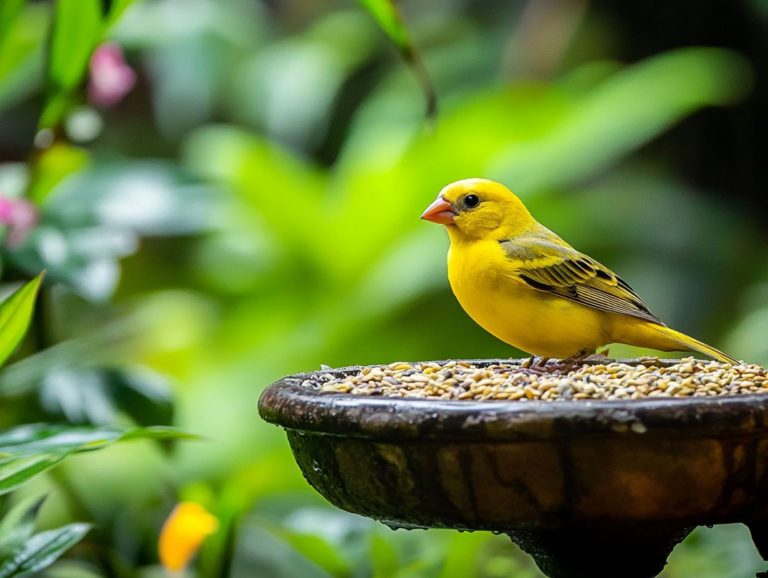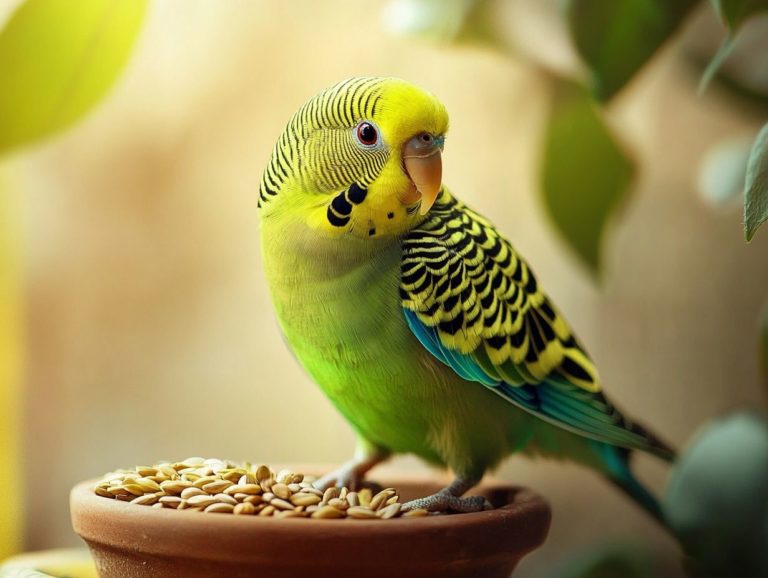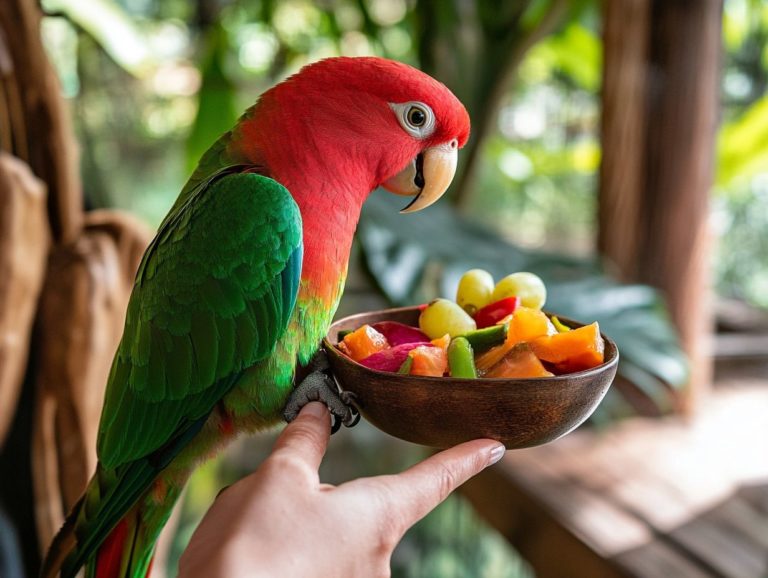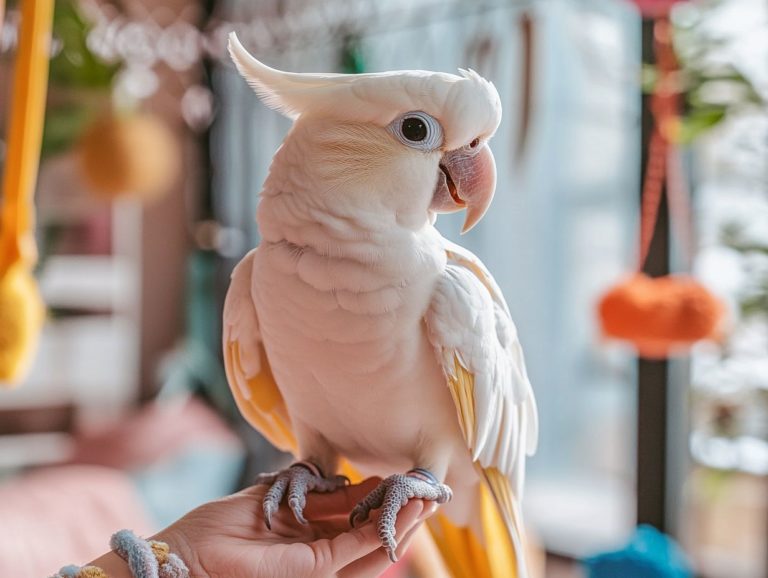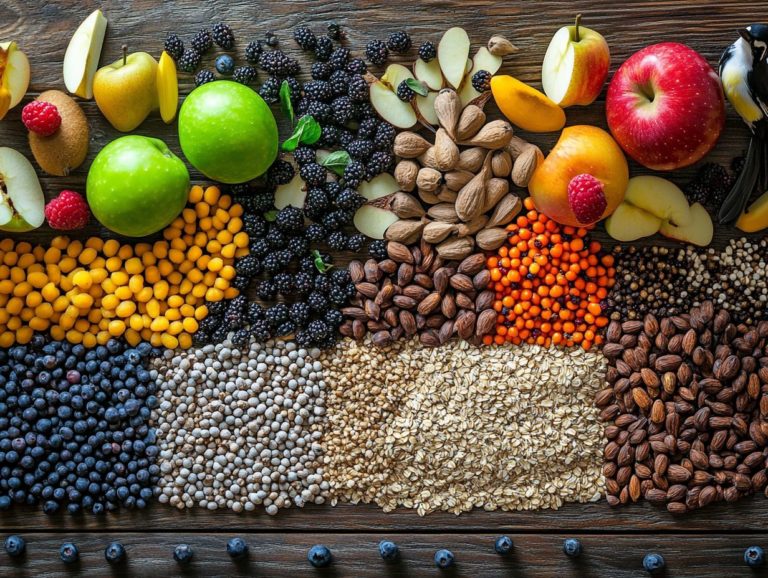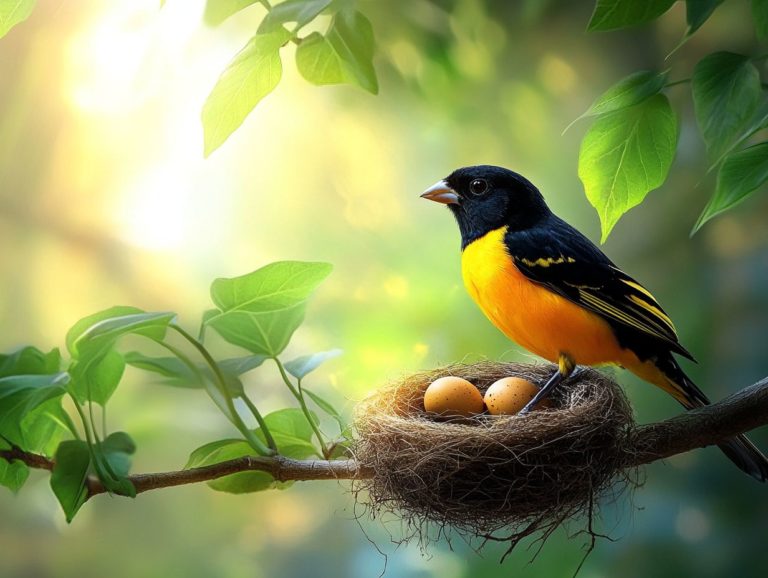5 Best Foods for Lovebirds
Feeding your lovebirds a balanced and nutritious diet is important for ensuring their health and happiness. With so many food options available, knowing the best choices can make a significant difference.
The five best food categories for these vibrant companions include:
- Seeds
- Fresh fruits
- Pellets
- Cooked meals
- Delightful treats
It s essential to determine the right portion sizes and feeding frequency. Recognizing which foods to avoid and understanding how diet impacts your lovebird s behavior and breeding success is also crucial.
You ll find helpful tips for introducing new foods and ways to add variety. Get ready to boost your lovebird’s diet and enrich their overall well-being!
Contents
Key Takeaways:
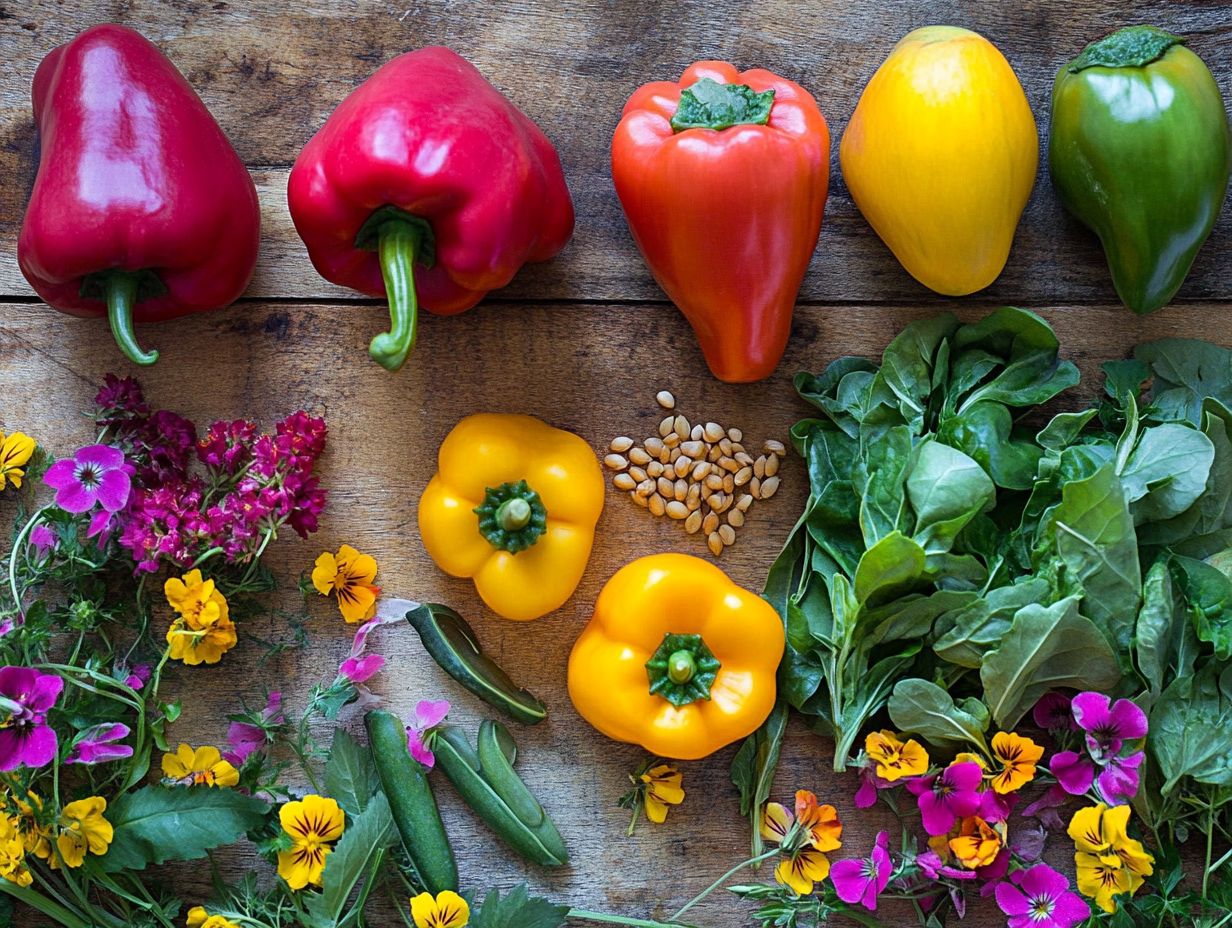
- Include seeds and grains in your lovebird’s diet for essential nutrients and enrichment.
- Offer a variety of fresh fruits and vegetables for a balanced and nutritious diet.
- Pellets can be a convenient and complete food option for lovebirds.
1. Seeds and Grains
Seeds and grains are important for the diet of your lovebirds. They provide essential nutrients and energy needed for thriving. This supports their well-being and contributes to their happiness in your home.
Experts like veterinary technician Deanne Pawlisch stress the significance of a balanced diet, enriched with fresh ingredients from reputable pet stores. Among the variety of seeds and nuts available, millet, canary seed, and safflower are particularly appealing to lovebirds due to their delightful taste and high energy content. Additionally, incorporating top fruits that birds enjoy can further enhance their diet.
These grains offer fats and proteins, along with vital vitamins and minerals essential for overall health. Incorporating pellets into their diet can help prevent nutritional deficiencies.
It’s wise to avoid seed mixes with excessive sunflower content, as these can lead to obesity. You can typically find high-quality options at specialized pet shops, ensuring your feathered companions receive the best possible nutrition for a vibrant and fulfilling life.
2. Fresh Fruits and Vegetables
Incorporating fresh fruits and vegetables into your lovebird’s diet enhances their nutrition. This ensures they receive vital vitamins and minerals essential for a healthy and vibrant life.
These colorful foods not only please the eye but also deliver crucial nutrients that bolster their immune system and overall well-being. For instance, leafy greens like kale and spinach are packed with calcium and iron, key for strong bones and healthy blood. Fruits like berries and apples provide antioxidants and fiber, promoting digestive health.
Introduce these foods gradually, starting with small amounts to observe their reactions, especially when training them to enjoy new ingredients. Lovebirds typically enjoy a variety of textures, so pairing soft fruits with crunchy vegetables can make mealtime delightful. Additionally, incorporating 5 superfoods for a healthier bird into their diet will help ensure your charming companions thrive with a well-rounded selection of safe options.
3. Pellets
Pellet food is often highly recommended by veterinarians as a vital component of your lovebird’s diet. It provides a well-rounded mix of nutrients that support their overall health and well-being.
These specially formulated pellets are crafted with high-quality ingredients, ensuring your lovebird receives the essential vitamins and minerals necessary for optimal growth and energy levels. By incorporating pellets into their daily meals, you can rest easy knowing that your feathered friend enjoys a comprehensive diet that extends far beyond what seeds and fresh produce can offer alone.
Additionally, these pelleted diets help prevent birds from only eating their favorite seeds, thereby missing out on crucial nutrients. Consult with your veterinarian for personalized recommendations, ensuring your lovebird’s diet remains diverse and nutritious, complemented by servings of seeds and fresh fruits or vegetables to enrich their overall intake.
4. Cooked Foods

Including cooked foods in your lovebirds’ diet introduces delightful tastes and textures essential for their dietary health. Just ensure these meals use safe ingredients like grains and legumes, and consider incorporating the 5 best protein sources for pet birds for optimal nutrition.
These vibrant birds can enjoy a variety of cooked delights, such as quinoa, brown rice, and lentils. These options provide great nutrients along with essential proteins, vitamins, and minerals. When preparing meals, leave out any additives like salt, sugar, or spices they can be harmful to your feathered friends.
Adding a mix of steamed vegetables, like carrots, peas, and sweet potatoes, can diversify your lovebirds’ meals. This not only enhances their dietary balance but also supports feather health and energy levels.
Simple recipes, like quinoa and vegetable medleys, are easy to prepare and can create a bonding experience for you and your cherished lovebirds, ensuring they receive high-quality ingredients.
5. Treats
Treats are a wonderful way to bond with your lovebirds, providing them with joyful dietary variety. Just remember to keep them healthy and give in moderation to avoid excess weight.
Healthy treats include many tasty options like fresh fruits, vegetables, and specially formulated seed mixes and pellet food designed to meet their nutritional needs. These treats offer mental stimulation and promote well-being by incorporating essential vitamins and minerals.
You can even whip up homemade treats, like baked birdie bread or dehydrated vegetable chips, with safe ingredients from your kitchen. Maintain balance in their diet to allow them to enjoy these treats without risking their health. Remember, moderation is key to nurturing a happy and healthy life for your feathered friends.
How Much and How Often Should Lovebirds Be Fed?
Feeding your lovebirds the right amount is key to their health, directly impacting their nutrition and overall well-being especially for baby lovebirds. Following recommendations from veterinary technicians like Deanne Pawlisch can help you establish a structured feeding regimen that meets their needs.
Feeding amounts can vary based on your lovebird’s age and activity level. Younger birds generally need more frequent meals to support their rapid growth and energetic lifestyles. In contrast, adult lovebirds usually do well with two meals a day, plus fresh fruits and vegetables for additional nutrients.
Don’t overlook the importance of health status in your feeding plan. For instance, a lovebird recovering from illness may need specially tailored food rich in specific vitamins and minerals. Regular consultations with avian veterinarians offer valuable insights into adjusting diets for different life stages, ensuring your vibrant companions receive the nourishment they need for a happy and healthy life.
What Foods Should Be Avoided for Lovebirds?
Some foods pose serious risks to lovebirds, so it’s essential to educate yourself about hazardous ingredients that could jeopardize their health. Additionally, offering yummy treats birds can’t resist can ensure they enjoy a safe and nutritious diet.
For example, avocados contain persin, a toxic substance that can harm their breathing and heart. Similarly, while chocolate is a favorite for many, it carries significant risks due to theobromine, which can lead to severe health complications. Be cautious with garlic and onions, as they can damage red blood cells over time.
Veterinary experts, including those from the American Veterinary Medical Association (AVMA) and the Veterinary Emergency and Critical Care Foundation, stress the importance of maintaining a balanced diet while avoiding these harmful foods. By knowing what to steer clear of, you can help ensure that your lovebirds thrive in a safe and nurturing environment.
How Can a Lovebird’s Diet Affect Their Behavior and Health?

A lovebird s diet is crucial for its behavior and health. Proper nutrition leads to a happier, more active bird.
Neglecting their dietary needs can lead to a host of health problems and behavioral challenges. For example, if their diet lacks essential fatty acids important fats that help keep lovebirds healthy you might notice issues like feather plucking or even aggression.
However, when you include a variety of seeds, greens, and fruits, you can significantly enhance their mood and social interactions. Case studies reveal that lovebirds on a balanced diet rich in 5 essential nutrients for pet birds, such as vitamins A, D, and E, exhibit increased stamina and bright feathers, contributing to better overall health.
Conversely, those fed primarily low-quality seed mixes often develop liver problems and show aggressive behavior toward their partners. This contrast shows how much your choices affect their health, especially when considering pet care guides.
What Are Some Tips for Introducing New Foods to Lovebirds?
Introducing new foods to your lovebirds can be a delightful journey that enriches their diet, but it requires a fun mix of patience and creativity to get them excited about healthy food!
By using a gradual introduction method, you can smoothly transition your feathered companions to a more varied menu. Start by mixing a small amount of fresh fruits and vegetables, such as carrots or leafy greens, with their regular pellets.
Pay close attention to their reactions. If they seem a bit unsure, experiment with different textures or vibrant colors that might catch their eye. Here are some tasty treats to start with:
- Sweet bell peppers
- Cucumbers
- Apples
Enhancing their diet with these new selections not only supports their health but also transforms mealtime into a more engaging and enjoyable experience for your lovebirds. Consider the recommendations from your local pet store for additional food options.
How Can a Balanced Diet Improve Breeding Success in Lovebirds?
A balanced diet is essential for enhancing your lovebirds’ breeding success. It significantly impacts their reproductive health, egg quality, and the overall vitality of both the parents and their chicks.
You ll want to ensure their diet is rich in essential nutrients. Incorporating protein sources like boiled eggs and high-quality pellets can dramatically improve their breeding performance. Don t overlook the importance of vitamins such as A, D3, and E; these are crucial for maintaining reproductive health, ensuring your lovebirds are in prime condition for breeding.
During the breeding season, it s advisable to up their intake of fresh fruits and vegetables. This not only provides necessary hydration but also delivers additional nutrients. Striking the right nutritional balance will enhance the parents’ physical condition and foster the proper development of embryos, resulting in healthier chicks.
By regularly monitoring their diet and incorporating various ingredients, including fresh fruits and vegetables, you can boost your chances of successful breeding!
Start improving your lovebird’s diet today, and watch them thrive!
What Are Some Creative Ways to Incorporate Variety into a Lovebird’s Diet?
A varied diet keeps your lovebird healthy and happy. It creates a stimulating eating experience with a mix of textures and flavors.
You can experiment by mixing different types of seeds, pellets, and grains. This mix keeps your feathered friend engaged and excited about mealtime. Seasonal fruits and vegetables are also crucial. Offering delights like fresh berries in the summer or root vegetables in the winter adds natural sweetness and hydration to their diet.
Introducing foraging toys elevates mealtime into a fun and interactive activity. These toys help birds find food, making mealtime exciting. This approach stimulates their natural behaviors and deepens the bond between you and your pet.
Watch your lovebird dive into a feast of colors and flavors!
Frequently Asked Questions
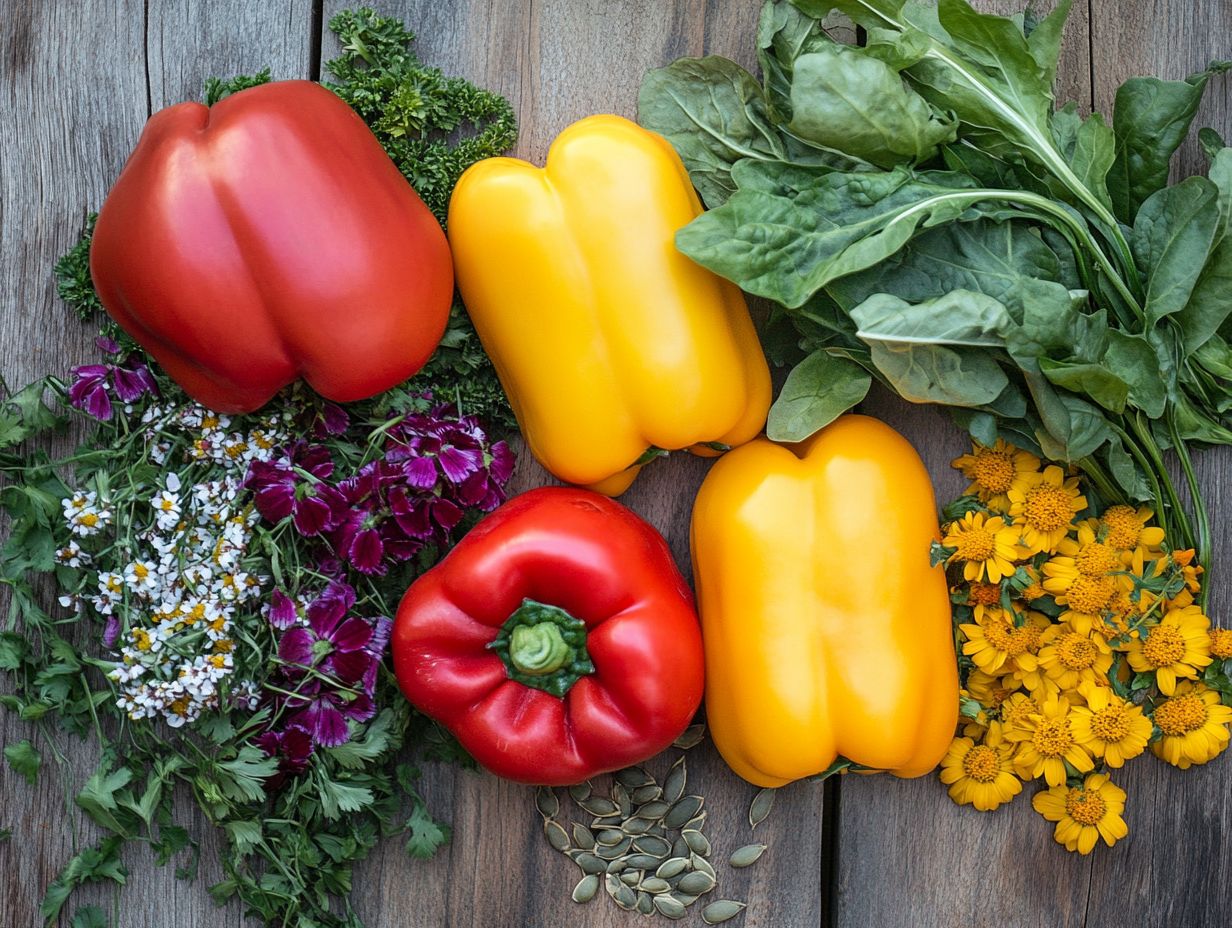
What are the 5 best foods for lovebirds?
- Fresh fruits such as apples, pears, and berries
- Leafy greens like spinach, kale, and Swiss chard
- High-quality pellets specifically designed for lovebirds
- Nutritious seeds and grains like millet, sunflower seeds, and quinoa
- Fresh vegetables like carrots, broccoli, and bell peppers
Why are fresh fruits important for lovebirds?
Fresh fruits provide essential vitamins and minerals that are necessary for their overall health. Lovebirds enjoy the sweetness of fruits, making them a great treat.
Do lovebirds need to eat leafy greens?
Yes, leafy greens are an important part of a lovebird’s diet. They provide necessary fiber and help with digestion.
Can lovebirds eat pellets?
Yes, lovebirds can eat pellets specifically designed for them. These pellets provide all the necessary nutrients for your lovebird’s health.
What are the best seeds and grains for lovebirds?
The best seeds and grains for lovebirds include millet, sunflower seeds, and quinoa. For optimal health, consider incorporating the best food combinations for parrots, as these provide necessary protein and energy for your lovebird.
Why should I include fresh vegetables in my lovebird’s diet?
Fresh vegetables are a great source of vitamins, minerals, and antioxidants for lovebirds. Incorporating 5 quick tips for feeding your bird can add variety to their diet and keep them interested in their food.

